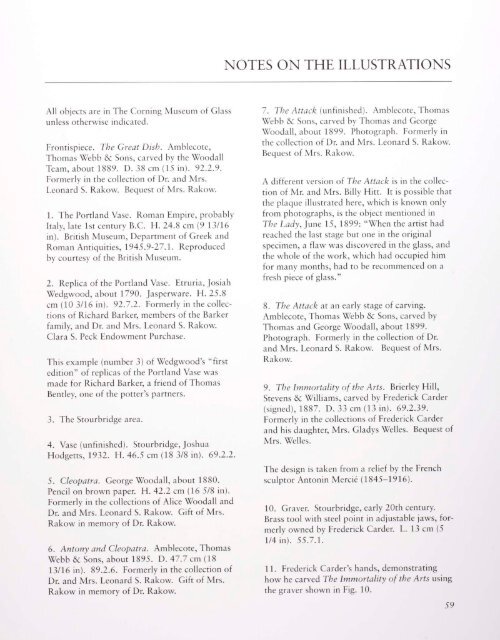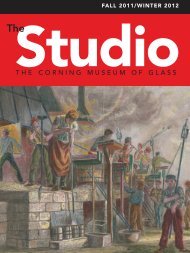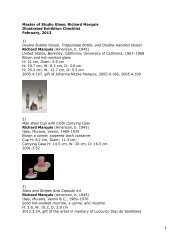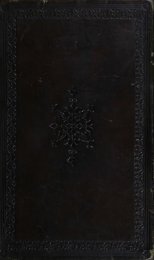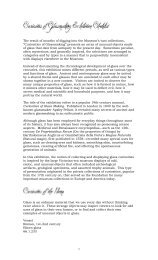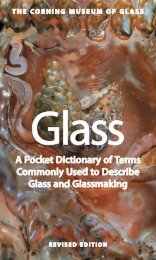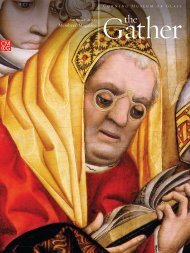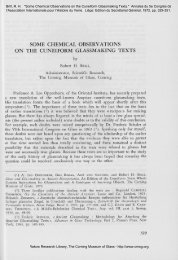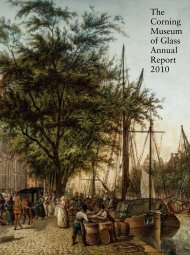english cameo glass in the corning museum of glass
english cameo glass in the corning museum of glass
english cameo glass in the corning museum of glass
Create successful ePaper yourself
Turn your PDF publications into a flip-book with our unique Google optimized e-Paper software.
All objects are <strong>in</strong> The Corn<strong>in</strong>g Museum <strong>of</strong> Glass<br />
unless o<strong>the</strong>rwise <strong>in</strong>dicated.<br />
Frontispiece. The Great Dish. Amblecote,<br />
Thomas Webb & Sons, carved by <strong>the</strong> Woodall<br />
Team, about 1889. D. 38 cm (15 <strong>in</strong>). 92.2.9.<br />
Formerly <strong>in</strong> <strong>the</strong> collection <strong>of</strong> Dr. and Mrs.<br />
Leonard S. Rakow. Bequest <strong>of</strong> Mrs. Rakow.<br />
1. The Portland Vase. Roman Empire, probably<br />
Italy, late 1st century B.C. H. 24.8 cm (9 13/16<br />
<strong>in</strong>). British Museum, Department <strong>of</strong> Greek and<br />
Roman Antiquities, 1945.9-27.1. Reproduced<br />
by courtesy <strong>of</strong> <strong>the</strong> British Museum.<br />
2. Replica <strong>of</strong> <strong>the</strong> Portland Vase. Etruria, Josiah<br />
Wedgwood, about 1790. Jasperware. H. 25.8<br />
cm (10 3/16 <strong>in</strong>). 92.7.2. Formerly <strong>in</strong> <strong>the</strong> collections<br />
<strong>of</strong> Richard Barker, members <strong>of</strong> <strong>the</strong> Barker<br />
family, and Dr. and Mrs. Leonard S. Rakow.<br />
Clara S. Peck Endowment Purchase.<br />
This example (number 3) <strong>of</strong> Wedgwood's "first<br />
edition" <strong>of</strong> replicas <strong>of</strong> <strong>the</strong> Portland Vase was<br />
made for Richard Barker, a friend <strong>of</strong> Thomas<br />
Bentley, one <strong>of</strong> <strong>the</strong> potter's partners.<br />
3. The Stourbridge area.<br />
4. Vase (unf<strong>in</strong>ished). Stourbridge, Joshua<br />
Hodgetts, 1932. H. 46.5 cm (18 3/8 <strong>in</strong>). 69.2.2.<br />
5. Cleopatra. George Woodall, about 1880.<br />
Pencil on brown paper. H. 42.2 cm (16 5/8 <strong>in</strong>).<br />
Formerly <strong>in</strong> <strong>the</strong> collections <strong>of</strong> Alice Woodall and<br />
Dr. and Mrs. Leonard S. Rakow. Gift <strong>of</strong> Mrs.<br />
Rakow <strong>in</strong> memory <strong>of</strong> Dr. Rakow.<br />
6. Antony and Cleopatra. Amblecote, Thomas<br />
Webb & Sons, about 1895. D. 47.7 cm (18<br />
13/16 <strong>in</strong>). 89.2.6. Formerly <strong>in</strong> <strong>the</strong> collection <strong>of</strong><br />
Dr. and Mrs. Leonard S. Rakow. Gift <strong>of</strong> Mrs.<br />
Rakow <strong>in</strong> memory <strong>of</strong> Dr. Rakow.<br />
NOTES ON THE ILLUSTRATIONS<br />
7. The Attack (unf<strong>in</strong>ished). Amblecote, Thomas<br />
Webb & Sons, carved by Thomas and George<br />
Woodall, about 1899. Photograph. Formerly <strong>in</strong><br />
<strong>the</strong> collection <strong>of</strong> Dr. and Mrs. Leonard S. Rakow.<br />
Bequest <strong>of</strong> Mrs. Rakow.<br />
A different version <strong>of</strong> The Attack is <strong>in</strong> <strong>the</strong> collection<br />
<strong>of</strong> Mr. and Mrs. Billy Hitt. It is possible that<br />
<strong>the</strong> plaque illustrated here, which is known only<br />
from photographs, is <strong>the</strong> object mentioned <strong>in</strong><br />
The Lady, June 15, 1899: "When <strong>the</strong> artist had<br />
reached <strong>the</strong> last stage but one <strong>in</strong> <strong>the</strong> orig<strong>in</strong>al<br />
specimen, a flaw was discovered <strong>in</strong> <strong>the</strong> <strong>glass</strong>, and<br />
<strong>the</strong> whole <strong>of</strong> <strong>the</strong> work, which had occupied him<br />
for many months, had to be recommenced on a<br />
fresh piece <strong>of</strong> <strong>glass</strong>."<br />
8. The Attack at an early stage <strong>of</strong> carv<strong>in</strong>g.<br />
Amblecote, Thomas Webb & Sons, carved by<br />
Thomas and George Woodall, about 1899.<br />
Photograph. Formerly <strong>in</strong> <strong>the</strong> collection <strong>of</strong> Dr.<br />
and Mrs. Leonard S. Rakow. Bequest <strong>of</strong> Mrs.<br />
Rakow.<br />
9. The Immortality <strong>of</strong> <strong>the</strong> Arts. Brierley Hill,<br />
Stevens &c Williams, carved by Frederick Carder<br />
(signed), 1887. D. 33 cm (13 <strong>in</strong>). 69.2.39.<br />
Formerly <strong>in</strong> <strong>the</strong> collections <strong>of</strong> Frederick Carder<br />
and his daughter, Mrs. Gladys Welles. Bequest <strong>of</strong><br />
Mrs. Welles.<br />
The design is taken from a relief by <strong>the</strong> French<br />
sculptor Anton<strong>in</strong> Mercie (1845-1916).<br />
10. Graver. Stourbridge, early 20th century.<br />
Brass tool with steel po<strong>in</strong>t <strong>in</strong> adjustable jaws, formerly<br />
owned by Frederick Carder. L. 13 cm (5<br />
1/4 <strong>in</strong>). 55.7.1.<br />
11. Frederick Carder's hands, demonstrat<strong>in</strong>g<br />
how he carved The Immortality <strong>of</strong> <strong>the</strong> Arts us<strong>in</strong>g<br />
<strong>the</strong> graver shown <strong>in</strong> Fig. 10.


